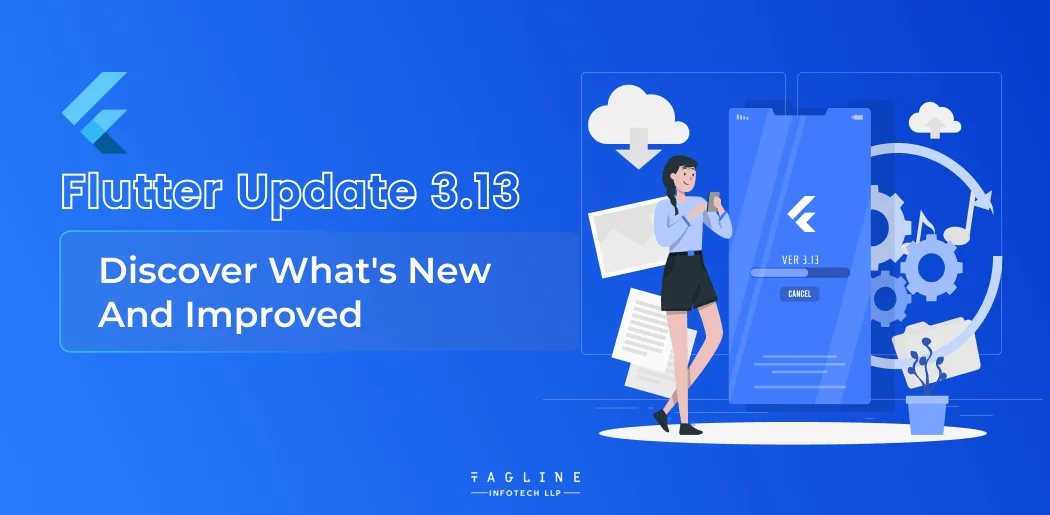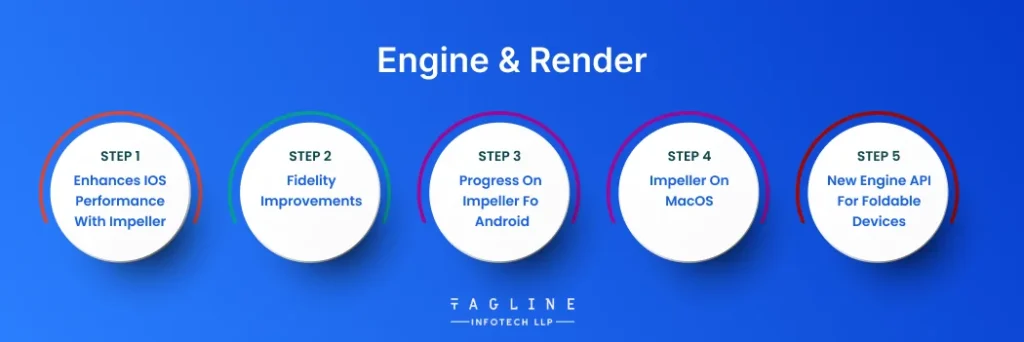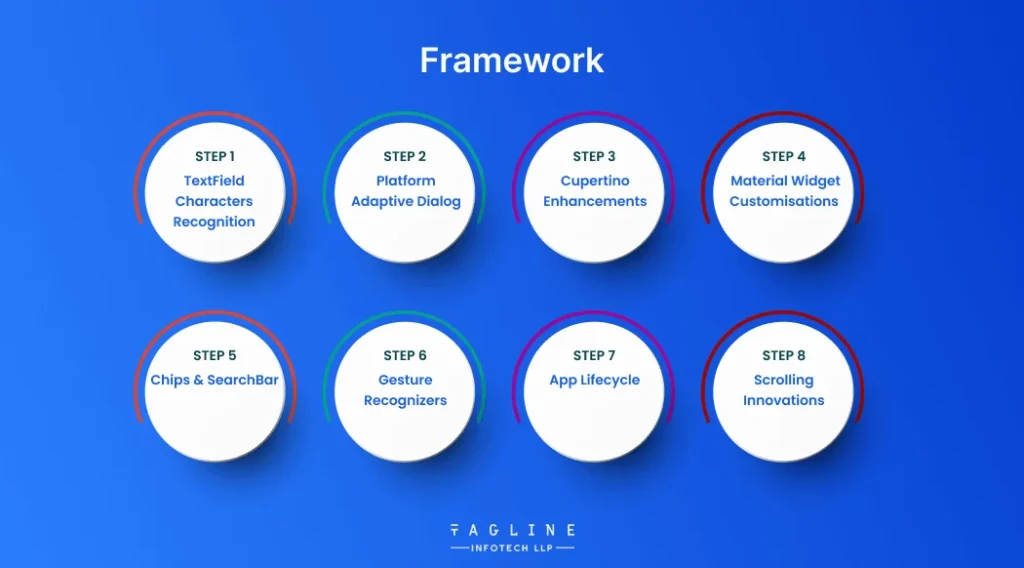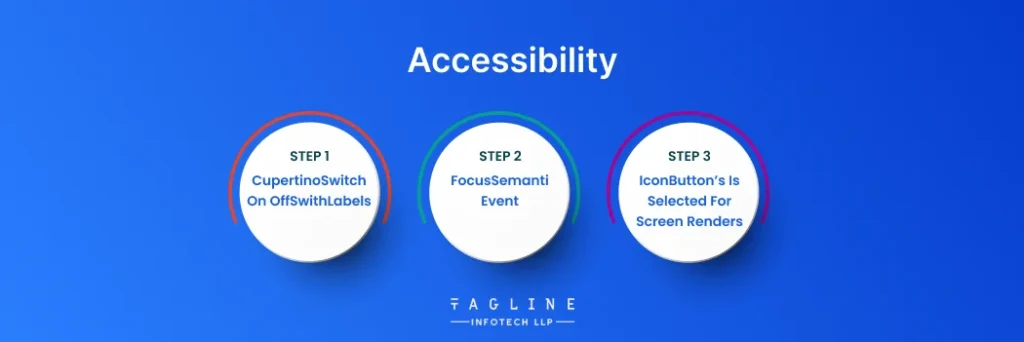Role of Python Libraries in Image Processing
October 30, 2025
Home >> Flutter >> Flutter Update 3.13: Discover What’s New and Improved

Quick Summary
Version 3.13 of Flutter is a milestone update filled with improvements. It features the Impeller renderer, which dramatically improves iOS speed and is now available on macOS. In Flutter Update 3.13 The framework is improved with new API support for foldable devices, character recognition in text fields, and platform-adaptive dialogues.
Flutter’s capabilities are further enhanced with accessibility features, platform compatibility for Android 14, and iOS upgrades. This significant version concludes with game creation capabilities, DevTools upgrades, and Material 3 as the default design style, making Flutter more powerful and user-friendly for developers.
Flutter version 3.3 served as a foundational update that improved performance and stability. It laid the groundwork for subsequent releases by enhancing the framework’s core capabilities, ensuring a more solid and reliable foundation for developers.
Building upon the foundation set by 3.3, the 3.7 release continued enhancing the developer experience. It focused on refining the framework, addressing known issues, and making Flutter a smoother and more user-friendly platform for app development.
In version 3.10, Flutter’s framework continued to evolve with feature upgrades and optimizations. This release introduced new functionalities and enhancements, empowering developers with tools and resources to create even more powerful and versatile apps.
The 3.13 release is a significant milestone in the Flutter journey, bringing many new features and improvements. It enhances Flutter’s capabilities, making it even more powerful and user-friendly. With this release, developers can expect richer tools and functionalities to create high-performance, engaging applications.

Flutter 3.13 Engine & Render Update so Flutter announces the Impeller renderer, which boasts improved performance on iOS, a macOS beta, and a new API designed specifically for foldable devices.
The speed of the Impeller renderer for iOS has been considerably improved in Flutter 3.13. Compared to its predecessor, Skia, the average frame rasterization time in the Flutter Gallery transitions performance benchmark on an iPhone 11 has been cut in half. This results in a more fluid and responsive user experience on iOS devices, resulting in more user engagement and satisfaction.
Following up from the 3.10 release, wide gamut colours, previously accessible as a flag with Impeller, are now the default on iOS. This change guarantees that applications display richer, brighter colours, improving visual appeal and making apps more interesting.
While the Vulkan backend for Impeller for Android is still under development, backend-agnostic optimizations made to Impeller’s HAL over the last year have benefited the OpenGL and Vulkan backends. Android users will have smoother app experiences shortly, providing optimal app performance across platforms.
Following the success of its iOS implementation, Impeller is now available in macOS preview. This update demonstrates Flutter’s dedication to consistent app performance across Apple devices, ensuring macOS users benefit from improved app responsiveness and visual quality.
Recognizing the growing popularity of foldable devices, Flutter 3.13 adds a new API for retrieving different display settings. This guarantees that programs are designed and optimized for these specific displays, resulting in a consistent user experience on the most recent devices.
“Introducing Flutter 3: Check Out What’s New? “
– Also Read Article
Material design updates, enhanced TextField and Dialogue features for iOS, Cupertino DatePicker, Radio modifications, and unique scrolling capabilities are included in the release.

On iOS, the TextField now supports camera-based character recognition. This novel innovation, resulting from a community collaboration, allows users to enter text by scanning it, expediting the data entry procedure.
The AlertDialog now has an adaptable constructor thanks to the upgrade. This guarantees that programmes show dialogues that are compatible with the original design of the platform, providing a consistent user experience across devices.
Several components in Cupertino have been upgraded:
Flutter 3.13 adds new design options for Material widgets. Developers have a variety of possibilities for customizing the user interface, from customizing the error widget in text fields to adding tooltips to ButtonSegment and altering the alignment in TabBar.
By Material 3 specifications, the upgrade offers enhanced FilterChip, ChoiceChip, and ActionChip forms. Furthermore, the SearchBar now has an onSubmitted function, which improves user engagement.
BaseTapAndDragGestureRecognizer, a new base class, has been introduced. This allows for various movements, such as tap + pan and tap + horizontal drag, which is useful for native text field gestures and other interactive features.
The AppLifecycleListener class tracks changes in the app lifecycle and allows developers to respond to particular lifecycle events, such as app termination requests.
Flutter 3.13 introduces various new classes and interactions, including diagonal scrolling, to create the groundwork for two-dimensional scrolling. This improvement, supported by user research, provides developers with a solid basis for creating dynamic scrolling experiences. Check out this DartPad example of a basic, lazy-loading, two-dimensional grid for a hands-on look. In addition, additional slivers such as SliverMainAxisGroup and SliverCrossAxisGroup have been added, allowing for unique scrolling effects.
The CupertinoSwitch has received a significant property upgrade to boost user engagement.

Including the CupertinoSwitch onOffSwitchLabels property helps users readily determine the switch’s status by showing I/O labels. This improvement gives instant response and assures a crisper and more intuitive user interface, especially useful for individuals who rely significantly on visual signals.
Including FocusSemanticEvent provides developers with an extra tool for managing focus events. It is critical, however, to utilize it sparingly to retain the anticipated behavior of a11y focus, ensuring that user interactions stay consistent and intuitive.
With IconButton’s selected quality presently open to screen perusers, outwardly impeded clients may be way better educated about the choice status of intuitive components. This improvement underlines the need to give nitty gritty criticism to all clients to construct a more comprehensive app environment.
Finally, the openness changes in Shudder 3.13 illustrate the platform’s commitment to consideration. Vacillate guarantees that apps cater to all clients, empowering smooth and total client involvement.
Flutter 3.13 adds support for Android 14 while also improving iOS functionality.
Flutter 3.13 now supports Android 14/API 34, allowing developers to create optimized apps for the most recent Android version.
1. Rotation Distortion Correction: Flutter has reduced screen rotation distortion, making the visual experience more aligned with native iOS apps.
2. More Naming Flexibility: Developers may now rename the default “Runner” Xcode project, which aids project organization.
3. iOS 17 and Xcode 15 compatibility: Flutter 3 is optimized for the future iOS 17 and Xcode 15, and we recommend downloading the iOS 17 simulator simultaneously.
These enhancements demonstrate Flutter’s commitment to improving cross-platform development, assuring app consistency and quality across Android and iOS.
Are you looking for a reliable partner to Build a Scalable Flutter App?
Hire our team of Experienced Flutter Developers to help you achieve your Demands! They can deliver high-quality app development services to meet your needs.
Flutter Games Toolkit was discharged in conjunction with the presentation of Flutter 3 in 2022. Whereas it was not coordinated for high-intensity 3D activity recreations, it did motivate Flutter to seek after casual gaming applications in a distinctive path.
This toolset included instructional exercises, diversion layouts, documentation, GCP/Firebase/Ad Credits, and community space for smooth amusement generation. Since then, handfuls of diversion apps have been made on the beat of Flutter. The group continuously investigates and overhauls interesting unused highlights to make strides in the amusement creation experience.
They have overhauled the with a carousel of modern recreations and video materials to help create a diversion. More modern highlights in this zone are guaranteed within the taking after months.
Flutter’s DevTools has seen significant speed and user experience enhancements. The major changes include:
Searching capabilities within the debugger have also been improved, with speeds up to five times quicker. For further information, refer to the release notes for DevTools 2.25.0 and DevTools 2.24.0.
The next Flutter stable version will embrace Material 3 as the default, providing better colors, text styles, and graphics. The Material 3 demo allows you to see the changes between the present Material 2 and the planned Material 3.
Flutter has discontinued support for Android Jelly Bean API levels (16, 17, and 18). Most apps will automatically move to the new minSdkVersion, but others may require special modifications. Plugin writers must also guarantee that their plugins are kept up to date.
This version also sees the retirement of several APIs designated for deprecation with the release of v3.10. Comprehensive migration guidelines and context are provided, with Flutter Fix supporting many modifications for smooth migrations.
Flutter 3.13 speaks to a significant jump forward within the world of app improvement. With upgrades crossing execution, system capabilities, availability, and stage back, it offers a vigorous toolkit for engineers. Get in touch with a Flutter development company if you are trying to get interactive mobile, web, and desktop applications.
The presentation of Impeller, bolster for foldable gadgets, and a commitment to availability exhibit Flutter’s devotion to brilliance. Moreover, the apparatuses and highlights for amusement improvement energize conceivable outcomes. With user-friendly upgrades and comprehensive documentation, Ripple becomes a flexible and energetic stage for app creators.
Flutter 3.13 incorporates improvements like CupertinoSwitch on OffSwitchLabels and FocusSemanticEvent, making apps more open and user-friendly for people dependent on assistive technologies.
Flutter Recreations Toolkit, discharged with Vacillate 3, offers assets, layouts, and documentation for diversion advancement. Whereas not perfect for high-intensity 3D recreations, it engages engineers to form casual gaming applications and ceaselessly makes strides.
Created with Solvase

Digital Valley, 423, Apple Square, beside Lajamni Chowk, Mota Varachha, Surat, Gujarat 394101
D-401, titanium city center, 100 feet anand nagar road, Ahmedabad-380015
+91 9913 808 2851133 Sampley Ln Leander, Texas, 78641
52 Godalming Avenue, wallington, London - SM6 8NW